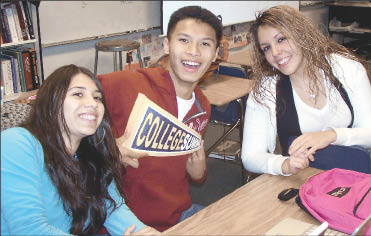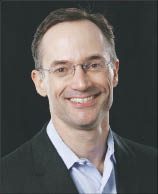 |
|
Fired up for college: Peer leaders reinforce each other’s college aspirations, and strive to influence their peers back in school. Photo: College Summit |
Princess Anne, Md.—Like so many inventors, J.B. Schramm began his experiment in the basement.
It was the basement of a low-income housing complex in Washington, D.C., where Schramm, fresh off graduation from Harvard Divinity School, directed a teen center run by Jubilee Housing, a faith-based nonprofit. He helped four low-income youths – the type who too often don’t move on to higher education, regardless of their abilities – get into college.
It gave Schramm an inspiration. “I saw so many students who were college-capable not going to college,” he says.
Thus began his vision for College Summit, which he launched two years later, in 1995, with 32 high school students at a Connecticut College campus workshop designed to infuse low-income high school seniors with the ambition, confidence and resources to move on to higher education. Since then, with campus workshops an important element, Schramm’s creation has reached a level of success that most youth programs only dream about.
This year, College Summit expects its various program elements to reach 17,000 high school seniors from 170 schools in 13 states. Over the past five years, its budget has soared from $4.5 million to $21.7 million, and Schramm has been heralded as a leader among the social entrepreneurs who are attacking problems with businesslike strategies.
Amid all the praise, however, College Summit has run into the same challenge that faces even a mom-and-pop youth program: How can you produce persuasive data to demonstrate that you’re doing what you say you are?
While College Summit has been lauded for guiding poor youths to college, the organization actually serves an economically mixed population – and it’s not clear just what that mix is. Many, and maybe even most, of its youths are not low-income, by any of the standard definitions.
 |
|
Telling their stories: Peer leaders work on their personal essays during a writing team session. Photo: College Summit |
So a question lingers: To what extent is College Summit helping steer youths to college who otherwise probably would not go?
This becomes an increasingly important question as efforts expand to help more low-income teens get into and succeed in college. The experience of College Summit illustrates how promising the mission can be, but also how tricky it is to reach those youths and evaluate the program.
‘Change Our Mindset’
There is little doubt that College Summit helps a lot of young people become enthusiastic about their prospects of going to college – and many of them end up in college.
At Beaumont High School in St. Louis, counselor Sonja P. Little says youths “are energized” by College Summit. At the Miller Career Academy in the same city, principal Stephen Warmack says the share of students applying to college has risen from 50 percent to 90 percent during the two years that College Summit has run its sessions there.
 |
|
Schramm: “I saw so many students who were college-capable not going to college.” Photo: College Summit |
Anecdotes abound about youths from poor families going to college because of College Summit, and they’ve been chronicled in such outlets as The New York Times, USA Today and The Wall Street Journal.
This year, Schramm was named Social Entrepreneur of the Year by the Schwab Foundation for Social Entrepreneurship. For the fifth year in a row, College Summit received a Social Capitalist Award from Fast Company, a magazine that put Schramm among its “heroes” who have found “a better way to do good.”
The Bill and Melinda Gates Foundation recently gave College Summit a three-year, $4.8 million grant.
Here’s what they are praising and paying for:
After his experience with the 1995 on-campus summer workshop, Schramm gradually spread that approach, taking groups of high school students to college campuses around the country. Some 3,000 attended one of 60 workshops last summer.
The typical workshop, which costs about $40,000 each, covers four days, with students living in campus dormitories and attending programs designed to introduce them to the types of colleges they could expect to attend and the financial aid that would probably be available, as well as to focus on the personal essay they will submit with their college applications.
Some critics say the essays focus too much on stereotypes of poverty and urban social pathology. An example, a student’s essay that read, in part, “I worry about living half my life in jail … about having a child at a young age … about living in poverty.”
But writing a compelling personal essay for college applications is an important feature of each workshop; seniors are encouraged to find “gold nuggets” in their experience that will grab college admissions people.
The underlying College Summit strategy is for summer workshop attendees, called “peer leaders,” to see themselves as college material and get them to influence their peers in school by taking their enthusiasm for college back to high school in the fall.
College Summit asks teachers and guidance counselors at participating schools to select for the workshops rising seniors who have special peer leadership potential. College Summit calls them “student influencers.”
Peer leaders are not necessarily the top students academically. Schramm says low-income students with top grades and test scores will probably be identified and recruited by colleges anyway. Instead, College Summit focuses its summer efforts on youths who are influential among their classmates.
“We’ve got to change our mindset from thinking of students as recipients of culture to thinking of them as drivers of culture, too,” Schramm explains. College Summit wants to influence the influencers first.
In 2004, College Summit embarked on an expansion plan to encourage local school districts to contract for in-school College Summit classes, including classes for all seniors in some districts. The in-school classes are a step-by-step approach to selecting colleges, completing applications and getting financial aid. The structure of the classes varies, depending on the design of the school’s academic calendar. At some schools, the classes for seniors take place daily or twice a week; at others, the College Summit curriculum is added to other existing courses.
College Summit has also broadened its outreach to include suburban and rural schools. That brings up the next question.
Who is Served?
College Summit regularly describes its mission in terms of the odds against low-income students going to college. For example, its website says, “National data indicate that low-income students who got A’s on a standardized test went to college at the same rate as top-income students who got D’s on the same standardized test.”
But who is classified as low-income? Youths are often considered low-income if they are eligible for free or reduced-price school lunches, which for a family of four would require annual income of no more than $39,220.
College Summit says it uses this free and reduced-price eligibility to calculate how “low- income” a school population is, and the information is readily available on Internet sites like http://www.greatschools.net. In some of the schools where College Summit operates, at least 75 percent of the students meet the free or reduced-price lunch definition. In others, however, the figure is barely more than 25 percent. It’s hard to say exactly how many of the seniors College Summit serves at a given time fit the free or reduced-price lunch definition.
A College Summit spokeswoman initially told Youth Today that slightly more than half of all students at participating schools are “low-income.” When pressed for more specifics, Schramm offered another measure: Eighty percent of its schools are at least 40 percent “low-income,” according to the free or reduced-price lunch standard.
That suggests that more than 60 percent of College Summit seniors could come from families above “low-income.”
Who Are the Peer Leaders?
College Summit also cites a 2007 survey of parents of workshop attendees – the peer leaders subgroup – in which 61 percent said their children were eligible for free or reduced-price lunches.
In academic terms, College Summit says the peer leaders tend to come from a “second tier” of students. Their average grade-point average, the organization says, is 2.9. Yet they are often well-rounded youths and reasonably good college material. But low-income students in this second tier of grades can be significantly underrepresented in college enrollment. College Summit’s website notes that nationwide, only 52 percent of “low-income” seniors enroll in college.
The website also points out that the College Summit peer leader group – which comes from more varied economic backgrounds – enrolls at an average rate of 79 percent.
But are the two groups truly comparable? College Summit says it draws data for its national figures from the National Center for Education Statistics (NCES), which says it uses an annual census survey of 50,000 homes that most recently put the upper limit of its “low-income” category at households with incomes lower than $16,800.
This NCES standard is far lower than the free or reduced-price lunch definition and could apply to only a fraction of College Summit seniors. There’s no way of knowing how many.
More Youths to College?
During its recent stretch of rapid growth, College Summit also tracked a steady rise in the rate of applications to college among seniors in schools that contracted with College Summit for peer leader workshops and in-school classes: from 47 percent in the 2003-04 school year to 56 percent the next year, and 67 percent in 2005-06.
In the same period, the demographic mix of College Summit appears to have broadened. The 12,000 seniors in College Summit programs in 2007-08 identified themselves in a survey as 42 percent black, 28 percent white and 21 percent Hispanic.
Schramm says College Summit is trying to develop better indicators of its specific success among low-income youth, the area of success that seems to have brought College Summit the most note. But some of the results are in the formative stages and still do not appear to delineate the actual number of low-income youths among College Summit participants.
Nevertheless, College Summit calculates from NCES data that nationally, enrollment among low-income youth rose 4 percent during 2004 and 2005, the last years for which national data are available, along with a 2.9 percent rise among middle-income youth and a 1.9 percent rise among those in upper-income families.
By comparison, during the 2006-07 and 2007-08 school years, Schramm says, college enrollment at schools with College Summit programs rose 15 percent from pre-College Summit levels.
“It appears we’re closing the college-going gap between low- and middle-income students,” Schramm says.
Observers See Success
Those most excited about College Summit’s success usually base their enthusiasm on what they’ve seen happen to youths in the program – and what might be possible if such successes could be repeated hundreds or thousands of times.
Donna Fleming, executive director of College Summit’s National Capital Region – which is made up of 22 high schools in and near Washington, D.C. – enthusiastically describes the societal benefit of even one poor youth getting a college education. “Support one student to get to college – change a family, change a community and, long-term, change our country,” Fleming says.
Fleming notes that this year, College Summit has gotten its first partner high school in Washington’s troubled public school system: the nearly 500-pupil Duke Ellington School of the Arts, which is 83 percent black.
Twenty-six percent of Ellington students are classified as low-income, according to school district data on free and reduced-price lunches.
In St. Louis, College Summit has contracts totaling $279,000 a year to conduct programs in all nine comprehensive public high schools, where all seniors attend twice-a-week College Summit classes.
“You have to create a culture – teachers, staff, counselors, all demonstrating and encouraging students that ‘You, too, can go to college,’ ” says Warmack, principal of the city’s 730-pupil Miller Creek Academy. Warmack says the share of students applying to college from his school rose from 50 percent to 90 percent in two years, with College Summit running sessions there.
Seventy-three percent of Miller Creek’s students are classified as low-income under the free or reduced-price lunch standard, school district figures indicate.
“It gives the children a reference point,” says Sonja P. Little, a counselor at St. Louis’ Beaumont High School, where 72 percent of students are classified as low-income, eligible for the free or reduced-price lunches. “College Summit has given us a curriculum,” she said, but she also sees a change in student attitudes.
“They’re an outside source telling our students, ‘You can do this.’ ”
College Summit doesn’t like to talk about what it charges for its services. Spokeswoman Vanessa Lillies said charges vary according to size and the school system’s financial resources. She said it often amounts to about 1 percent of a school system’s per student expenditure.
Youths See the Future
The enthusiasm of peer leaders was evident among 46 rising seniors who gathered at the University of Maryland Eastern Shore, in Princess Anne, Md., one August weekend. Some said they were particularly excited about the sense of mutual support that was emerging among fellow participants from their own schools.
“Having this group that knows each other – it’s huge,” said Dayne Kenley, then a rising senior at Duval High School in Prince George’s County, Md. “The energy here is really high.”
Duval High is 84 percent black, and 40 percent of its students are listed as eligible for free or reduced-price lunches.
But a few African-American youths urged a Youth Today reporter not to write a story about College Summit like one that had appeared a week earlier in The New York Times, which they said focused too much on stereotypes of poverty and urban social pathology. They said they didn’t identify with that image.
To be sure, some peer leaders do come from troubled urban neighborhoods. The Times told of a 17-year-old Washington, D.C., student who was shot dead five days after attending a College Summit workshop in Towson, Md.
The overall economic status of the majority of youths College Summit helps remains unclear, as well as how many would probably have gone to college anyway. What is clear is that College Summit lifts many youths’ ambitions and their sense of their own possibilities.
Says Little, the counselor in St. Louis, “The kids we have at Beaumont are energized.”





























